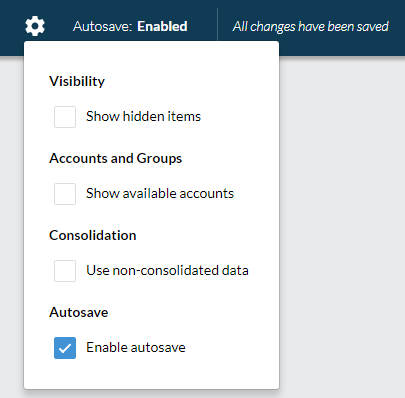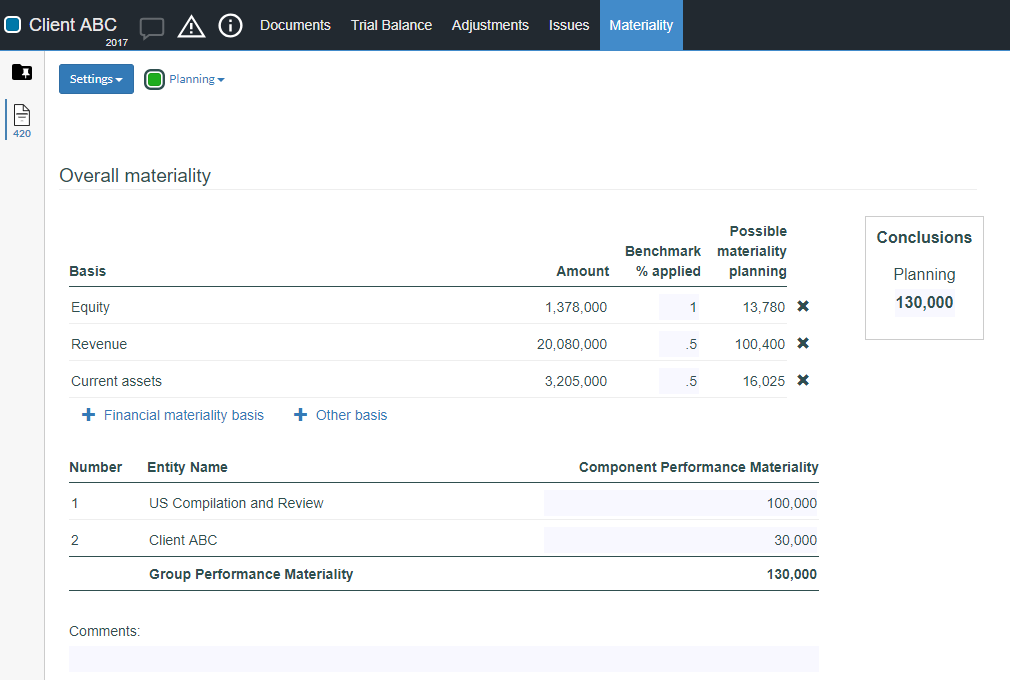What's new - OnPoint PCR 12-2018
Here is a listing of what's new for the December 2018 release of OnPoint PCR.
Revisions for professional standards
- Updated for SSARS 24, excluding AR-C 100, Special Considerations - International Reporting Issues (which will be included in a future release)
- OnPoint PCR (PCR) assumes early adoption of SSARS 24, which, except as indicated in item ii., is effective for compilations and reviews of financial statements for periods ending on or after June 15, 2019.
- The SSARS 24 revision to AR-C 90.39, which was effective upon issuance in May, 2018, was included in the previous version of PCR.
- Updated for recently issued, or soon to be effective, FASB Accounting Standards Updates, including the revenue recognition standards. See the guidance section of the disclosure checklist optimizer for further information about standards included in the disclosure checklist.
Interim engagements
- Interim period engagements for monthly, quarterly and semi-annual reporting periods (including comparative periods) are now supported.
- Assumes the same type of engagement is being performed for each interim period during the year. (If a different type of engagement is performed at year end, a new engagement would need to be set up for that engagement.)
- An engagement letter is created in the first period file and will cover all interim engagements for the period. The reports and financial statements will be for the specific period. The signed engagement letter will roll forward during each period covered.
- The period end date now appears in the trial balance if interim reporting is being used.
- You can now define the period on CSV or Excel import.
Carry forward
- Carry forward allows you to carry forward the following between periods
- Procedure responses in checklists
- Adjustments to, creations of, and movements of procedures in checklists and entire documents
- Adjustments to the engagement letter and financial statements (including reports thereon)
- For annual engagements, the prior year adjusted trial balances will carry forward to the PY column in documents, including the financial statements.
- You can now see prior period modifications to text areas that are available to be carried forward. Changes made in the previous period are optionally given as a choice between accepting and denying for the current period.
- Financial information in dynamic tables is now automatically carried forward when the financial statement is opened after a carry forward.
- When you carry forward an engagement file, you can now view procedures that were added or modified by the firm author between versions.
- Values within the materiality form now carry forward from year-to-year for annual engagements.
Analytics in a review engagement
- Added a link to a new HTML document with common analytics performed for key areas.
Consolidations
- PCR now provides the ability to consolidate multiple 100% owned entities and includes
- An interactive consolidation hierarchy
- Multiple financial statement and trial balance layouts
- The same functionality and automation as stand-alone files (with the exception of interim periods)
- This version allows you to carry forward a consolidated annual engagement. (Carry forward of a consolidated interim engagement to be included in a future release.)
Dynamic text
- You can now identify and modify dynamic text that is being used and see an explanation of the condition that is causing the term to show
Dynamic tables
- The interface for editing mode in dynamic tables has been updated. Now, when you are editing a dynamic table, you can
- Automatically save all changes through autosave

- Cancel any changes you have made to the table
- Save your changes and continue to work in editing mode, or
- Save your changes and close editing mode.
These four options replace the Done option that previously saved all changes and closed editing mode.
- Automatically save all changes through autosave
- A Done button has been added to the column settings area for dynamic tables. When editing a dynamic table, you can now use this button to collapse the column settings area once you have finished changing them.
Trial balance
- You can now create trial balance groups under unassignable parent groups.
- You can now display import source and company name in a trial balance after import.
- During an interim engagement, you can now view period end balances in the trial balance and other locations where balances are saved.
Adjustments
- The Tax Adjustments option will only be displayed on the trial balance settings if the tax adjustments feature is enabled for the product.
Materiality
- Subsections of your materiality document will display based on whether the engagement is being performed on consolidated entities. This enables you to create materiality sections that are specific to consolidations, and those sections will only be displayed in consolidated engagements.
- You can now break down materiality between the parent and the subsidiaries in a consolidated file.

Visibility
-
The Year Start date now appears in the Engagement Properties screen when the period is set to Annual.
-
You can now add issues, edit visibility, and change print settings on grouping areas you have created.
Engagement glossary
- The engagement glossary allows you to add complexity to the automatically-generated letters and report by appropriately tailoring based on your responses in the engagement criteria on the client acceptance and continuance form for things such as the reporting period (e.g. monthly, quarterly, semi-annually, annually), applicable supplementary schedules, and consolidation. The responses will be appropriately inserted throughout the client's engagement letters, files, and report. As with all items in PCR, it is your responsibility to review documents for accuracy and exercise professional judgment in all areas.
- The engagement glossary allows you to see an explanation of the condition that is causing the term to be displayed.
PBC queries
- The query interface has been enhanced through the use of optimizers to further filter document and review inquiry requests to clients.
- In each query, the wording included in the instructions to clients is now conditional based upon the firm's preferred pronoun
- Guidance no longer shows when it is blank.
- You can now see when, and by whom, a file was uploaded into an engagement.
- To avoid confusion, the term "procedure" in query documents has been replaced with the term "query."
- The Allow sign offs checkbox has been removed from the Procedure Settings dialog.
- The status drop-downs in queries have been replaced with buttons that are dynamically shown based on the query's current status
- Because queries are rarely sent to all contacts, the Assign to all contacts checkbox in the Open Query dialog is now deselected by default.
Reviewer tools
- You can now differentiate sections of a document included by default from sections added by your staff. Using the Added filter, you can now highlight all sections of a document created by a staff member.
Permanent file
- We have simplified the permanent file folder structure and the document request query to the client. The document request form has been simplified and an external link with suggestions on documents to request has been added to the guidance area.
Import
- Based on feedback, "Login" has been changed to "Connect" in the Xero import dialog.
- Following a Trial Balance import, you can now see when Xero was the data source, and the name of the connected Xero organization.
